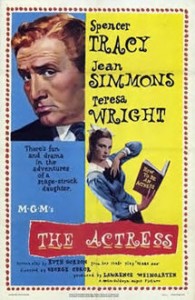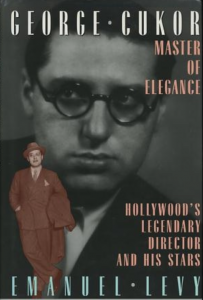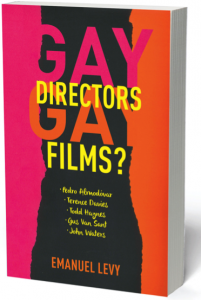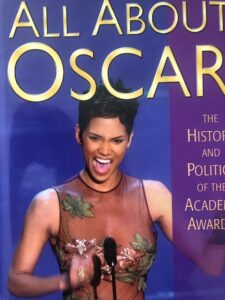George Cukor’s biopic, The Actress, based on Ruth Gordon’s autobiographical play “Years Ago,” represents an ultra-modest and conventional filmmaking—by any standard.
One of the few truly boring pictures to be directed by Cukor.
Grade: C (*1/2* out of *****)
This period piece–a nostalgic slice of Americana differs from Cukor’s other films with the Garson Kanin and Ruth Gordon.
Unfortunately, Cukor treats the material too reverentially, which results in an uncharacteristically earnest, sentimental–and dull–picture.
Note:
If you want to know more about George Cukor, please read my biography:
Despite the title, the central character in “The Actress” is the girl’s gruff but lovable father (Spencer Tracy). It was a richly textured part, calling for an actor who’s harsh on the outside but tender inside, for which Tracy was the natural choice, and which he played marvelously.
The first preview of “The Actress,” or “Fame and Fortune,” as it was then called, was good, but Cukor faced two major problems. One was length. Audiences were restless. The other problem was sound. There was “throw-away dialogue,” which caused some confusion, particularly in the first reel. Audiences insist on hearing and understanding every word,” producer Weingarten told Cukor, as if he were telling him something new.
Weingarten promised to make no cuts, until he discussed them with Cukor. Weingarten told the Kanins that Cukor’s direction was “truly creative,” but despite the reconciliatory tone of his comments, a battle between Cukor and Weingarten over the final cut was beginning and it was anything but friendly.
At the film’s second preview, there was not even one walkout. The comedy played brilliantly, and Tracy’s big scene, speaking of his childhood, was applauded. Though the preview audiences didn’t like Jean Simmons much, Cukor defended her as a new performer. He argued that if preview audiences had similarly reacted to Katharine Hepburn’s debut, in “Bill of Divorcement,” Hollywood would have missed a great star.
However, when Cukor ran the new dubbed version, he became even more furious. A deplorable job, which distorted the otherwise high quality of acting, was done–despite his demand for absolutely accurate sound transference. Instructions were given to the crew to keep the “highs” in Jean Simmons’s voice down. Unfortunately, the redubbing resulted in an evening out–Simmons sounded much older than her age and devoid of vitality.
Teresa Wright’s homey voice was smoothed out as well, and lines that Tracy threw away were hiked up so that the audience would hear them. The delicacy and individuality were dissipated by the editors. Cukor determined that, if his interference didn’t help, he would ask Tracy to step in and throw his weight.
A third preview was held at the Fox Theater in Inglewood. Once again, a majority of viewers said they would recommend the film. In October l953, after the Kanins saw the film, they praised Cukor’s imaginative work with extraordinarily difficult material. They, too, criticized Weingarten’s foolish cutting, which made the story confusing. Fully aware of Cukor’s battle with the front office, Garson tried to console him by saying that, no matter how hard one worked, there came a time, when the project is placed in the hands of “popcorn salesmen.”
“There was a very pernicious habit,” Cukor later told interviewer Gavin Lambert, “when you finished a picture, everybody had a panacea! People who hadn’t contributed very much would say, `Oh, you can cut this and that, and it will fix everything.'”
What Cukor deemed as lack of “taste and discretion” in handling the picture was also reflected in the choice of its title. Weingarten was in favor of “The Father and the Actress,” which was suggested by the New York office. Cukor noted that they might as well call it “Father’s Little Actress,” after MGM’s “Father’s Little Dividend,” which also starred Tracy, under Minnelli’s helm. Finally, the title was changed from “Fame and Fortune” to “The Actress,” which also was a bad–he said “banal”–title in Cukor’s opinion.
Unfortunately, none of the cuts was helpful. “The Actress” didn’t do particularly well at the box office. The film was a critical success in England, but it was a “commercial frost” in the U.S. “MGM just didn’t know what they had in the film,” Teresa Wright told me, “They didn’t publicize the film, and the word-of-mouth was not very good.”
At one point, Cukor suggested rising star Debbie Reynolds for the lead, as she was an all-American girl, unlike Simmons who was British and projected a more sophisticated air. Reynolds was greatly disappointed when MGM executive Dore Schary decided not to cast her in that role after her breakthrough in the musical hit, Singin’ in the Rain.
Anthony Perkins made his screen debut in that picture.
Greeted with mixed to negative review, The Actress was a box-office flop.
Oscar Alert
Oscar Nominations: 1
The film was nominated for Walter Plunkett’s black-and-white Costume Design Oscar, but the winner was Edith Head, who dressed Audrey Hepburn in “Roman Holiday.”
Cast
Spencer Tracy as Clinton Jones
Jean Simmons as Ruth Gordon Jones
Teresa Wright as Annie Jones
Anthony Perkins as Fred Whitmarsh (film debut)
Ian Wolfe as Mr. Bagley
Kay Williams as Hazel Dawn
Mary Wickes as Emma Glavey
Norma Jean Nilsson as Anna Williams
Dawn Bender as Katherine Follets
Jackie Coogan as Inopportune (uncredited)
Credits:
Directed by George Cukor
Written by Ruth Gordon
Produced by Lawrence Weingarten
Cinematography Harold Rosson
Edited by George Boemler
Music by Bronisław Kaper
Production company: Metro-Goldwyn-Mayer
Distributed by Loew’s Inc.
Release date: September 25, 1953
Running time: 90 minutes
Budget $1,424,000
Box office $914,000














